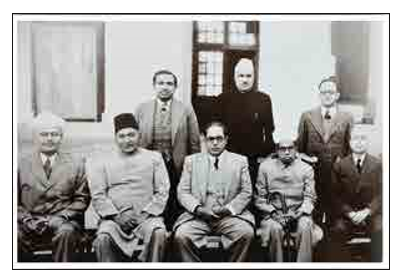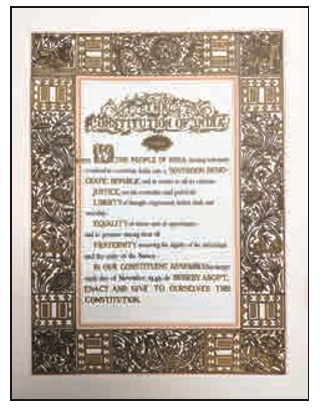The Constitution of India Notes 6th Social Science
The Constitution of India Notes 6th Social Science
6th Social Science Lesson 14 Notes in English
14. The Constitution of India
1. Define Constitution of India:
In order to administer people who follow different religions, speak different languages and belong to different castes and culture and treat everyone equally, we need to have a good code of laws and guidelines which we call as ‘The Constitution of India.’2. Why Republic day is celebrated?
Our Constitution was framed and came into existence from 26th January 1950. That is why every year we observe this day as the Republic Day.
3. Why Republic Day is celebrated on 26th January?
When the Congress met at Lahore in 1929, the members of the Congress unofficially declared the same day as the Day of Poorna Swaraj or the Day of complete self governance. The next year, 26th January 1930 was celebrated as the Independence Day. That day has been observed as our Republic Day.
4. What is Constitution?
The Constitution is an authentic document containing the basic ideas, principles and laws of a country. It also defines the rights and duties of citizens. The laws governing a country originate from the consitutition. Every country is ruled on the basis of its constitution.
5. What are the things that make the constitution of India?
The constitution of India is the ultimate law. We have to abide by it. It explains the fundamental concepts of structure, methods powers and the duties of Government bodies. It also lists the fundamental rights and duties of the citizens. Directive Principles are also mentioned in the constitution. So it is holistic in nature.
6th Social Book Back Questions
6. When did they begin to frame the constitution?
In 1946, nearly 389 members of the constituent Assembly who belonged to different parties from different places came together to frame the Constitution of India. The Chairman of the committee was Mr. Rajendra Prasad.
7. Who were the other significant members in the Constituent Assembly?
Jawaharlal Nehru, Sardar Vallabai Patel, Moulana Azad, S. Radhakrishnan, Viajalakshmi Pandit and Sarojini Naidu were the members in the Constituent Assembly.

8. How many women members were there in the Constituent Assembly?
15 women members were in the Constituent Assembly.
9. ‘The Father of the Constitution of India’ is Dr.B.R. Ambedkar.
10. When and How was the drafting committee formed?
The Drafting committee was formed with eight members and its Chairman was B.R. Ambedkar. B.N.Rao was appointed as an advisor. The committee met for the first time on 9th December 1946. On the same day, the drafting of constitution of India started.
11. How did they form the Indian constitution?
The constitutions of nearly 60 countries including the UK, USA,former USSR, France , Switzerland etc., were thoroughly examined and their best features have been adopted by our constitution.
12. Did they draft it in a short span of time?
No, nearly 2000 amendments were made before the draft was finalised.
13. When did they complete this work?
It took a period of 2 years, 11 months, and 17 days.
14. When was the work of Constitution Completed?
It was completed on 26th November 1949.The constitution was accepted by the Constituent Assembly. So, 26th November is celebrated as the Day of the Constitution.
15. How much was spent to frame the constitution of India?
They spent almost 64 lakhs.
16. What are the objectives of the Constitution?
The Preamble of our constitution stresses on the justice, liberty, equality and fraternity.
17. What is a Preamble?
The preface of the constitution is the Preamble. According to it, India is a Sovereign, socialist, Secular democratic republic.

18. What does it mean by ‘Sovereign’?
The constitution has granted the people the right to rule. The members of the parliament and the legislative assembly are elected by the people. The right to decide is only in the hands of the representatives. Sovereignty refers to the ultimate power of the country.
19. What is the meaning of Secular?
Law allows all the citizens of a country, the right to follow different faith and religious beliefs. All citizens enjoy the freedom of worship. The country does not have a religion of its own. All the religions in our country hold the same status.
20. Why Government of India rules through the Parliament?
The Constitution of India provides a Parliamentary form of Government, both at the centre and the state. In a Parliamentary System, the Executive is collectively responsible to the Legislature. The party which has the majority forms the government.
21. What are fundamental rights?
Fundamental rights are the basic human rights of all citizens.
22. Name the Fundamental Rights?
They are Right to Equality. Right to freedom, Right against exploitation, Right to freedom of Religion, Cultural and Educational Rights and Right to Constitutional Remedies.
23. What are Directive Principles of State Policy?
There are certain guidelines to be followed while the governments frame law. Though these are not mandatory, they should be taken into account.
24. What is Universal Adult Franchise?
Every Indian citizen has the right to vote when they attain 18 years of age, irrespective of any caste, religion, gender or economic status.
25. What are Fundamental Duties?
There are duties respecting the National flag and National Anthem, respect and protect the Constitution, follow our great leaders who fought for our freedom, to protect our country, readiness to serve our country if necessary, treating everyone as brothers irrespective of their castes, religions, languages, races etc., to conserve our ancient heritage, and conserve natural elements like forests, rivers and lakes and fauna, to develop science, humanity and feelings of reformation to avoid non-violence and protect government property, parents or guardians providing educational opportunities to children between 6-14 years etc., have been added as our duties.
26. The original copies of the Cons titution of India (Hindi, English) are preserved in special Helium filled cases in the Library of the Parliament of India.
27. Dr. B.R. Ambedkar, N. Gopalasamy,K.M.Munshi, Syed Ahmed sadullah, P.L. Mitter, N.Madhava Rao, T.T.K,T.P. Khaitan were the legal experts of the Drafting Committee.
28. The Chairman of the Drafting Committee Dr. B.R. Ambedkar was considered the Chief architect.
29. When the Constitution was drafted, there were 395 articles in 22 parts and 8 schedules. At present our Indian Constitution contains 448 articles in 25 parts and 12 schedules.
30. 101 amendments were made till 16.09.2016.